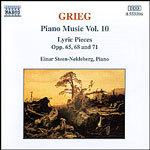
Piano Music Vol 10 (Lyric Pieces, Books 8-10, Opp. 65, 68, and 71)
 $25.00
Out of Stock
$25.00
Out of Stock6+ weeks add to cart
GRIEG
Piano Music Vol 10 (Lyric Pieces, Books 8-10, Opp. 65, 68, and 71)
Einar Steen-Nokleberg (piano)
[ Naxos / CD ]
Release Date: Tuesday 16 November 2004
This item is currently out of stock. It may take 6 or more weeks to obtain from when you place your order as this is a specialist product.
"Steen-Nøkleberg is entirely inside this music. He manages to make the familiar pieces sound fresh, and the less familiar... are most imaginatively played."
- Gramophone - May 1996
"There is plenty of lovely music here. The project is executed with great skill and originality by Steen-Nokleberg."
- Fanfare (U.S.A.) - May/June 1996
"...completion of this valuable series...A parade of largely unfamiliar music, excellently played and recorded."
- Classic CD - July 1996
Edvard Grieg was born in Bergen, on the west coast of Norway, in 1843. He showed a strong interest in music at a very early age, and after encouragement from the violinist and composer Ole Bull (1810 -1880) was sent to the Conservatory in Leipzig at the age of fifteen to receive his musical education. There he had fundamental and solid musical training, and through the city's flourishing musical life, received impressions and heard music which would come to leave its stamp on him for the rest of his life - for better or for worse. Even though he severely criticized the Leipzig Conservatory, especially towards the end of his life, in reality his exceptional gifts were recognised, and one sees in his sketchbooks of the Leipzig period that he had the freedom to experiment as well. He had no good reason to criticize the conservatory, nor his teachers, for poor teaching or a lack of understanding.
From Leipzig Grieg travelled to Copenhagen, bringing with him the solid musical training he had acquired, and there soon became known as a promising young composer. It was not long before he carne under the influence of Rikard Nordraak, whose glowing enthusiasm and unshakeable belief that the key to a successful future for Norwegian music lay in nationalism, in the uniquely Norwegian, the music of the people - folk-songs - came to play a decisive role in Grieg's development as a composer. Nordraak's influence is most obvious in the Humoresques for piano, Op. 6, which was considered a turning-point in Grieg's career as a composer.
Tracks:
Lyriske stykker, hefte 8, op. 65 (Lyric Pieces, Book 8, Op. 65)
1. Fra ungdomsdagene (From days of youth)
2. Bondens sang(Peasant's Song)
3. Tungsind (Melancholy)
4. salong (Drawing-Room) .
5. I balladetone (ln Ba1lad Style)
6. Bry1lupsdag p.i. Troldhaugen (Wedding-Day at Troldhaugen)
Lyriske stykker, hefte 9, op. 68 (Lyric Pieces, Book 9, Op. 68)
1. Matrosenes opsang (Sailor's Song)
2. Bestemors menuett (Grandmother's Minuet)
3. For dine fotter (At Your Feet)
4. Aften p.i. hoyfje1let (Evening in the Mountains)
5. Badnlat (Cradle-Song)
6. Valse melancolique (Melancholy Waltz)
Lyriske stykker, hefte 10, op. 71 (Lyric Pieces, Book 10, Op. 71)
1. Det var engang (Once upon a time)
2. Sommeraften (Surnmer Evening)
3. smatrold (Puck)
4. skovsti1lhed (Peace of the Woods)
5. Halling (Norwegian Dance)
6. Forbi (Gone)
7. Efterklang (Remembrances)

